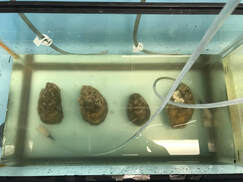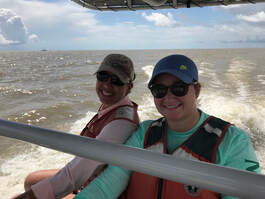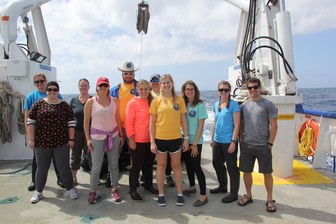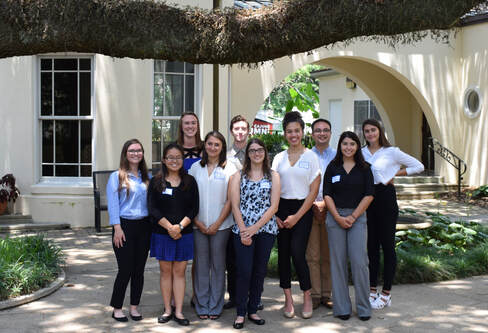Current and Ongoing Projects
 Oysters being exposed to natural communities amended with cyanobacteria
Oysters being exposed to natural communities amended with cyanobacteria
Phytoplankton-Oyster Interactions and Coastal Restoration:
Dr. Stauffer is Lead PI of the LO-SPAT project, a $14M project focused on better understanding oyster tolerance to low salinity and applying that understanding to shellfish production and coastal restoration (website coming soon!). Our lab's contributions to this applied research project continues work we've started with oyster experts (see below) to understand how changes in oyster prey communities (i.e., phytoplankton) with salinity represent co-stressors to these important and tasty bivalves. This project is supported by LA Department of Wildlife & Fisheries and the Coastal Protection & Restoration Authority. Want to join the LO-SPAT team? Check out open positions and opportunities on the People page.
In collaboration with Drs. Megan and Jerome LaPeyre (LSU), we are investigating the effects of changing environmental conditions and phytoplankton community composition - as predicted to occur with large-scale river diversions and ongoing climate change - on oyster feeding on those communities. A pilot version of this project was supported by the Institute of Coastal and Water Research (ICaWR) at UL Lafayette and a full project was supported by Louisiana Sea Grant College Program.
Dr. Stauffer is Lead PI of the LO-SPAT project, a $14M project focused on better understanding oyster tolerance to low salinity and applying that understanding to shellfish production and coastal restoration (website coming soon!). Our lab's contributions to this applied research project continues work we've started with oyster experts (see below) to understand how changes in oyster prey communities (i.e., phytoplankton) with salinity represent co-stressors to these important and tasty bivalves. This project is supported by LA Department of Wildlife & Fisheries and the Coastal Protection & Restoration Authority. Want to join the LO-SPAT team? Check out open positions and opportunities on the People page.
In collaboration with Drs. Megan and Jerome LaPeyre (LSU), we are investigating the effects of changing environmental conditions and phytoplankton community composition - as predicted to occur with large-scale river diversions and ongoing climate change - on oyster feeding on those communities. A pilot version of this project was supported by the Institute of Coastal and Water Research (ICaWR) at UL Lafayette and a full project was supported by Louisiana Sea Grant College Program.
 Stauffer Lab members sampling the environment via small boat in Vermilion Bay
Stauffer Lab members sampling the environment via small boat in Vermilion Bay
Phytoplankton communities, food webs, and ocean acidification:
We participated in the Gulf of Mexico Ecosystems and Carbon GOMECC-3 and GOMECC-4 cruises in 2017 and 2021. In collaboration with the NOAA AOML Lab in Miami, FL and researchers from multiple countries, we collected samples to characterize the plankton communities throughout regimes of the Gulf affected by hypoxia, HABs, and ocean acidification, and conducted grazing experiments to determine the relative effects of micro- and mesozooplankton grazing. This work has been supported by NOAA Ocean Acidification Program.
Changing phytoplankton communities and emerging HABs in Louisiana estuaries:
With over two years of spatial data and 5+ years of timeseries data, we are beginning to better understand how phytoplankton community structure in the highly river-influenced Atchafalaya-Vermilion Bay system respond to river influence, mixing, and changes in grazing pressure. We are also quantifying cyanobacteria toxins in these very low salinity estuaries, and results are suggesting that microcystins are often present and at non-negligible concentrations. This work is funded by Louisiana Sea Grant, USGS LWRRI (cyanotoxin project), with additional support from NOAA, the Cypremort Point Yacht Club, and LA Dept. of Wildlife and Fisheries.
We participated in the Gulf of Mexico Ecosystems and Carbon GOMECC-3 and GOMECC-4 cruises in 2017 and 2021. In collaboration with the NOAA AOML Lab in Miami, FL and researchers from multiple countries, we collected samples to characterize the plankton communities throughout regimes of the Gulf affected by hypoxia, HABs, and ocean acidification, and conducted grazing experiments to determine the relative effects of micro- and mesozooplankton grazing. This work has been supported by NOAA Ocean Acidification Program.
Changing phytoplankton communities and emerging HABs in Louisiana estuaries:
With over two years of spatial data and 5+ years of timeseries data, we are beginning to better understand how phytoplankton community structure in the highly river-influenced Atchafalaya-Vermilion Bay system respond to river influence, mixing, and changes in grazing pressure. We are also quantifying cyanobacteria toxins in these very low salinity estuaries, and results are suggesting that microcystins are often present and at non-negligible concentrations. This work is funded by Louisiana Sea Grant, USGS LWRRI (cyanotoxin project), with additional support from NOAA, the Cypremort Point Yacht Club, and LA Dept. of Wildlife and Fisheries.
 Rapid Plankton 3 cruise team (credit: S. Paxton)
Rapid Plankton 3 cruise team (credit: S. Paxton)
Effects of Extreme Events on Plankton Food Webs:
Dr. Stauffer is a CoPI of the newly-launched NSF Research Coordination Network for Hurricane Ecosystem Response Synthesis (RCN-HERS) focused on synthesizing data and understanding of ecosystem responses to hurricanes. Check out the RCN-HERS website and stay tuned for collaborative webinars and workshops through the network. This work is supported by the National Science Foundation.
Previously, we worked with collaborators at UL Lafayette (Dr. Kelly Robinson), NC State University (Dr. Astrid Schnetzer), and Texas A&M University Corpus Christi (Dr. Simon Geist), to understand how phytoplankton communities changed in the intermediate and mid-term aftermath of devastating Hurricane Harvey in 2017. In our own backyard, we also worked to assess the effects of the 2019 Mississippi River flood on plankton communities throughout the Atchafalaya-Vermilion Bay system. This work has been supported by the National Science Foundation and Louisiana Sea Grant.
Dr. Stauffer is a CoPI of the newly-launched NSF Research Coordination Network for Hurricane Ecosystem Response Synthesis (RCN-HERS) focused on synthesizing data and understanding of ecosystem responses to hurricanes. Check out the RCN-HERS website and stay tuned for collaborative webinars and workshops through the network. This work is supported by the National Science Foundation.
Previously, we worked with collaborators at UL Lafayette (Dr. Kelly Robinson), NC State University (Dr. Astrid Schnetzer), and Texas A&M University Corpus Christi (Dr. Simon Geist), to understand how phytoplankton communities changed in the intermediate and mid-term aftermath of devastating Hurricane Harvey in 2017. In our own backyard, we also worked to assess the effects of the 2019 Mississippi River flood on plankton communities throughout the Atchafalaya-Vermilion Bay system. This work has been supported by the National Science Foundation and Louisiana Sea Grant.
Food Web Interactions Among Protists:
Protists are single-celled eukaryotes which include phytoplankton and many protistan consumers (e.g., "protozoa" or "microzooplankton"). As such, there are many interactions between these organisms in coastal marine food webs. Continuing work in the Stauffer Lab seeks to quantify the role protistan grazing of phytoplankton species plays in controlling biomass and composition of plankton communities in coastal marine ecosystems. Recent work by Ph.D. student Gulce Kurtay is teasing apart the relative contributions of different size-based groups of protistan consumers to the integrated grazing rates that we see in Louisiana estuarine and shelf ecosystems.
Protists are single-celled eukaryotes which include phytoplankton and many protistan consumers (e.g., "protozoa" or "microzooplankton"). As such, there are many interactions between these organisms in coastal marine food webs. Continuing work in the Stauffer Lab seeks to quantify the role protistan grazing of phytoplankton species plays in controlling biomass and composition of plankton communities in coastal marine ecosystems. Recent work by Ph.D. student Gulce Kurtay is teasing apart the relative contributions of different size-based groups of protistan consumers to the integrated grazing rates that we see in Louisiana estuarine and shelf ecosystems.
 GOM monitoring partners in the learning how to operate the Systea WIZ Nitrate probe
GOM monitoring partners in the learning how to operate the Systea WIZ Nitrate probe
Technologies to Support Coastal and Environmental Research:
As part of our ongoing collaboration with the Alliance for Coastal Technologies (ACT), we are working with colleagues to test sensors and toxin quantification methods that allow for more field-based and near-real-time detection of harmful algal blooms (HABs). Results of those tests are published as reports on the ACT website. We are also working with ACT, the U.S. Environmental Protection Agency (EPA), and the Gulf of Mexico Coastal Ocean Observing System (GCOOS) to implement a pilot network of nitrate sensors in the Gulf of Mexico. Data from the nitrate sensor deployed by Sanibel-Captiva Conservation Foundation (SCCF) is now available on the GCOOS website!
Funding for these projects is provided by the NOAA Integrated Ocean Observing System (IOOS) and GCOOS.
As part of our ongoing collaboration with the Alliance for Coastal Technologies (ACT), we are working with colleagues to test sensors and toxin quantification methods that allow for more field-based and near-real-time detection of harmful algal blooms (HABs). Results of those tests are published as reports on the ACT website. We are also working with ACT, the U.S. Environmental Protection Agency (EPA), and the Gulf of Mexico Coastal Ocean Observing System (GCOOS) to implement a pilot network of nitrate sensors in the Gulf of Mexico. Data from the nitrate sensor deployed by Sanibel-Captiva Conservation Foundation (SCCF) is now available on the GCOOS website!
Funding for these projects is provided by the NOAA Integrated Ocean Observing System (IOOS) and GCOOS.
 Students in the 2018 Healthy Streams, Healthy Coasts REU Program
Students in the 2018 Healthy Streams, Healthy Coasts REU Program
Past Projects
Healthy Streams, Healthy Coasts Research Experience for Undergraduates (REU) program:
The REU program at the University of Louisiana at Lafayette (UL Lafayette) provided ~10 students each summer the opportunity to participate in research on topics in watershed and coastal processes and resources within the southern Louisiana environments. We completed three in-person (and 1 virtual) summers between 2018 and 2021. This project was supported by NSF.
Envisioning the future of eDNA: Through ACT, we worked with experts in environmental, or "eDNA," from within NOAA (including MBON and others) and from the research, management, and technology communities to envision the future of eDNA sampling and sample processing. We held two virtual workshops on this theme in June and September 2020. The workshop report is available on the ACT website and presentations from developers of eDNA solutions can be accessed at this link.
Nitrogen use by estuarine phytoplankton: We have collaborated with the NSF-funded TIDE project in Plum Island Estuary, MA, to quantify nitrogen use by different size classes of phytoplankton over diurnal and spring/neap tidal cycles. This work was part of Jaylyn Babitch's Masters thesis and published in Estuaries & Coasts in 2020 (see Publications page).
Technology Innovation for Cleaner Water: With partners in federal agencies, academia, and industry, we are continuing to tackle the important issue of nutrient pollution in watersheds and coastal ecosystems through a combination of open innovation tools, technology development, and investments in social and behavioral change across stakeholder communities. We are continuing our work with the Nutrient Sensor Challenge, an effort to accelerate the development and use of affordable nutrient sensors for use in water and am also engaged in projects focusing on watershed-scale monitoring and management. As a partner in the Alliance for Coastal Technologies, the Stauffer Lab will be participating in the upcoming Challenge Summit and Beta Testing at the Chesapeake Biological Laboratory in Solomons, MD.
Phytoplankton community composition in the southeastern Bering Sea: Polar regions of our world's oceans are under significant climatic pressure as climate continues to change, resulting in increased sea surface temperatures, reduced sea ice extent, and earlier retreat of sea ice each year. The Bering Sea is home to significant fisheries for the U.S. and other countries, and changes in the phytoplankton and zooplankton communities in this region have the potential for great impact on the food webs and fishery stocks. As a postdoctoral fellow, I participated in cruises and analyzed mooring-based datasets to show high degrees of interannual variability in the phytoplankton community response to climatic drivers and decoupling of primary and secondary producers from climatic and hydrographic conditions in warmer years. I also blogged from the 2012 cruise, which you can check out here!
Ecological observing in nearshore marine & estuarine ecosystems: King Harbor, the primary field site for my PhD work, experienced a massive fish kill in March 2011 at a time when I led in situ sensor and discrete sampling programs in the harbor. By augmenting those existing efforts with boat- and autonomous underwater vehicle (AUV)-based tools, we were able to correlate the fill kill with upwelling-driven hypoxia and an influx of a large population of sardine. We were also able to show that the mortality event was not driven by a HAB event within the harbor, as was originally assumed. However, a dense bloom of Pseudonitzschia spp. offshore at the time of the mortality event and significant concentrations of domoic acid detected in fish stomachs raised questions about potentially non-lethal impacts of this neurotoxin on fish behavior.
Healthy Streams, Healthy Coasts Research Experience for Undergraduates (REU) program:
The REU program at the University of Louisiana at Lafayette (UL Lafayette) provided ~10 students each summer the opportunity to participate in research on topics in watershed and coastal processes and resources within the southern Louisiana environments. We completed three in-person (and 1 virtual) summers between 2018 and 2021. This project was supported by NSF.
Envisioning the future of eDNA: Through ACT, we worked with experts in environmental, or "eDNA," from within NOAA (including MBON and others) and from the research, management, and technology communities to envision the future of eDNA sampling and sample processing. We held two virtual workshops on this theme in June and September 2020. The workshop report is available on the ACT website and presentations from developers of eDNA solutions can be accessed at this link.
Nitrogen use by estuarine phytoplankton: We have collaborated with the NSF-funded TIDE project in Plum Island Estuary, MA, to quantify nitrogen use by different size classes of phytoplankton over diurnal and spring/neap tidal cycles. This work was part of Jaylyn Babitch's Masters thesis and published in Estuaries & Coasts in 2020 (see Publications page).
Technology Innovation for Cleaner Water: With partners in federal agencies, academia, and industry, we are continuing to tackle the important issue of nutrient pollution in watersheds and coastal ecosystems through a combination of open innovation tools, technology development, and investments in social and behavioral change across stakeholder communities. We are continuing our work with the Nutrient Sensor Challenge, an effort to accelerate the development and use of affordable nutrient sensors for use in water and am also engaged in projects focusing on watershed-scale monitoring and management. As a partner in the Alliance for Coastal Technologies, the Stauffer Lab will be participating in the upcoming Challenge Summit and Beta Testing at the Chesapeake Biological Laboratory in Solomons, MD.
Phytoplankton community composition in the southeastern Bering Sea: Polar regions of our world's oceans are under significant climatic pressure as climate continues to change, resulting in increased sea surface temperatures, reduced sea ice extent, and earlier retreat of sea ice each year. The Bering Sea is home to significant fisheries for the U.S. and other countries, and changes in the phytoplankton and zooplankton communities in this region have the potential for great impact on the food webs and fishery stocks. As a postdoctoral fellow, I participated in cruises and analyzed mooring-based datasets to show high degrees of interannual variability in the phytoplankton community response to climatic drivers and decoupling of primary and secondary producers from climatic and hydrographic conditions in warmer years. I also blogged from the 2012 cruise, which you can check out here!
Ecological observing in nearshore marine & estuarine ecosystems: King Harbor, the primary field site for my PhD work, experienced a massive fish kill in March 2011 at a time when I led in situ sensor and discrete sampling programs in the harbor. By augmenting those existing efforts with boat- and autonomous underwater vehicle (AUV)-based tools, we were able to correlate the fill kill with upwelling-driven hypoxia and an influx of a large population of sardine. We were also able to show that the mortality event was not driven by a HAB event within the harbor, as was originally assumed. However, a dense bloom of Pseudonitzschia spp. offshore at the time of the mortality event and significant concentrations of domoic acid detected in fish stomachs raised questions about potentially non-lethal impacts of this neurotoxin on fish behavior.
Proudly powered by Weebly